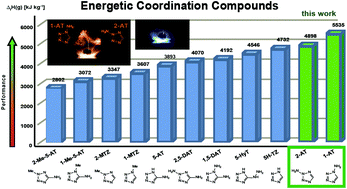Maximization of the energy capability level in transition metal complexes through application of 1-amino- and 2-amino-5H-tetrazole ligands†
Abstract
Toxic lead compounds (especially lead azide and lead styphnate), reliable but highly harmful compounds, still dominate the field of primary explosives used in most ignition and initiation systems to this day. Therefore, an extensive investigation into energetic materials with similar performance and minimized toxicity led to the very promising strategy of developing energetic coordination compounds (ECC). For the first time in literature, two isomeric amino-5H-tetrazoles with sensitivities already in the range of primaries, which could be obtained via practicable, easily scalable synthesis, proved to be very promising new energetic ECC ligands. By variation of the respective isomer (1-AT, 2-AT), metal(II) center (MnII, FeII, CuII, ZnII) and the corresponding counter-anion (Cl−, NO3−, ClO3−, ClO4−, styphnate, trinitrophloroglucinate) desired properties could be tailored gradually, yielding 20 new, highly energetic and easily accessible transition metal(II) complexes. In addition to comprehensive characterization by XRD, IR, EA, solid-state UV/Vis, DTA and TGA, BAM standard sensitivity measurements as well as ESD and ball drop impact sensitivities were determined. Classical initiation tests (nitropenta filled detonator) validated the present approach to be extraordinarily promising for potential use in advanced initiation systems. Beyond successfully achieving set goals in terms of sensitivity and toxicity, investigated complexes match or even outperform lead-based primaries' high performance and, more importantly, do not necessarily depend on initiation by mechanical stimuli. Laser irradiation of the received primary explosives with near-infrared light (NIR) yielded initiation reliably and safely, further extending their potential for future applications.



 Please wait while we load your content...
Please wait while we load your content...